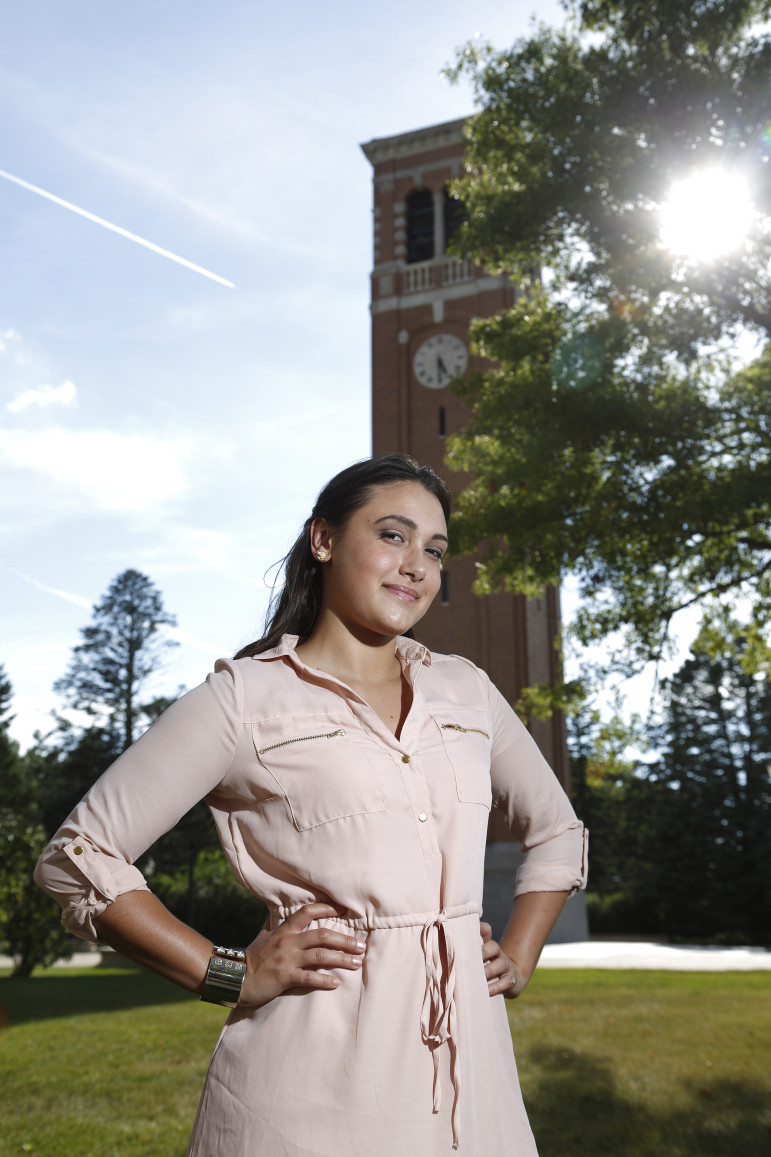![]() This story is also running on National Public Radio’s Shots blog.
This story is also running on National Public Radio’s Shots blog.
Laticia Aossey was flat on her back in a hospital bed in Iowa with one tube up her nose, a needle for a peripheral IV for fluids stuck in one arm, and monitors galore pasted to her body. Then one more thing was stuck into her: a figurative knife through the heart. A friend brought Aossey’s mail from home. It was early June 2014, a week after her 18th birthday, and one letter in the bundle was as ominous as it gets for a teenager who is fighting an illness and has no parents. Aossey’s health insurance was about to be cut off.
A ward of the state of Iowa as a foster child, Aossey was accustomed to life’s harsh spins, but this pending calamity was especially harsh. She had been diagnosed with a rare stomach disorder, SMA Syndrome, and Laticia immediately assumed the worst when she read the insurance company was on the verge of discontinuing her coverage.
“My heart dropped. I just wondered to myself, ‘Are they going to pull this tube out, unhook me from everything, and roll me down to the street?’” Aossey said. “Could I get the medicine I needed?”
When children “age out” of foster care at age 18 in Iowa, they are eligible to receive Medicaid under the Affordable Care Act until they turn 26. When Aossey turned 18, she did not fill out the necessary paperwork to stay eligible. She knows she “messed up,” but the life of foster youth can be arduous — and solitary. She was about to go into the hospital on her 18th birthday with abdominal pain, which included stomach ulcers, acid reflux and cyclical vomiting. Filling out paperwork was not as much a priority as dealing with the pain.
She was in college at the University of Northern Iowa, so instead of using her dormitory address she used a friend’s home address. The state Medicaid office sent the paperwork to complete her health-care enrollment to her friend’s address in Iowa City, so she did not receive it right away.
“The first call I made from the hospital to get it straightened out, the woman said, ‘Your parents need to call,’” Aossey said. “My parents? I was in foster care. I had no parents. Then she said my caseworker, an adult, my boss, somebody … [other than] me had to call. She wouldn’t talk to me. I was 18.”
Advocates say foster youth not only deal with red tape and bureaucrats, they have to deal with politics, which can be just as onerous. Medicaid is a joint state/federal program that serves 80 million low-income Americans, and not all states want to work with the federal government when it comes to so-called Obamacare and its Medicaid expansion.
Aossey is one of 400,000 foster youth in the nation and approximately 23,000 per year who “age out” when they turn 18 (or 21 in some states). They are eligible for Medicaid, regardless of income, under ACA until 26. Federal law requires states to cover former foster youth, and the federal government provides states with Medicaid matching funds at the regular Medicaid matching rate for the state.
Celeste Bodner, the founder and executive director of Foster Club, a national advocacy organization for foster youth, said “Anti-Obamacare bureaucrats” wrongly assume former foster youth are part of President Barack Obama’s plan for Medicaid expansion for low-income citizens. Many states vigorously fight additional Medicaid enrollments for low-income people because of the cost to the states, she said. Instead of being helped, foster youth are caught in the flying flak of politics.
“In some states, where the state is not embracing ACA in general, there wouldn’t be a particular incentive for them to inform young people of their eligibility,” Bodner said. “If you want to call that a hostile environment, I don’t think that is a stretch.”
Aossey was trapped in the maze. Her doctors finally calmed her fears, and couple of days later, she said, a caseworker arrived to help her fill out the paperwork she said she could have managed herself before things became complicated in the hospital.
“Be an adult,” Aossey advises foster youth. “Find a way to do your paperwork. Do not rely on other people for something you should do.”
Is that it? Is that the extent of help for foster youth who have to do battle with the bureaucracy and red tape of a $300 billion dollar beast that is Medicaid? Do it yourself?
White hats and good guys
In California and New York, foster youth who “aged out” of foster care after Jan. 1, 2014, were automatically enrolled in Medicaid and are covered until they are 26. Eliminating paperwork and the need for yet another application helps solve part of the issue of insuring foster youth.
More problematic, say advocates, is the population of foster youth who aged out before the foster youth benefits of the Affordable Care Act became law Jan. 1, 2014. Those who turned 18 before Jan.1, 2014 but are still under 26 have to reapply for Medicaid, and many do not know they are eligible for free health care until they turn 26.
Kari Siddiqui, a policy analyst for the Schuyler Center for Analysis and Advocacy (SCAA) in Albany, N.Y., said SCAA has created a toolkit to help educate eligible foster youth and explain that they have health insurance and can see a doctor. The toolkit includes a social media campaign, youth outreach in community centers and youth groups, and outreach in community-based health centers in New York.
Foster youth can feel disconnected and distrustful because many have been let down by the system, so it is not an easy task to pull them back in. Siddiqui said other foster youth who have used the benefits are a strong ally for foster care agencies.When a program works for young people, they tend to share information with other foster youth, Siddiqui said.
It also helps to have a champion on your side: a city councilman or a state representative, for example.
“We have been fortunate in New York that the state government really wanted to make improved coverage for foster youth happen and make sure they get these benefits they are entitled to,” Siddiqui said. “I know some advocates in states have gone through their legislatures to push improved coverage for foster youth. They have used youth voices to testify before the legislature about what coverage means for them. That is really effective in gaining a champion.”
[Related: A Hole in the Safety Net Offered by the Affordable Care Act]
Ronald E. Richter, the CEO of the Jewish Child Care Association and former commissioner of New York City’s Administration for Children’s Services, said JCCA spends significant resources in making sure foster youth who are still in their care get prepared for hitting the streets as independents. JCCA works with 750 foster youth of all faiths and backgrounds in New York. When they are about to age out they have discharge conferences with key people in their life, such as their case planner, guidance counselors, teachers, friends, foster parents and perhaps a doctor. Among other pieces of advice, foster youth are given guidance on filling prescriptions and managing their care.
“A lot of children in the foster care system are not equipped with practical skills because, hopefully, they have been taken care of,” Richter said. “Before they exit the system they need to know how to do certain things that young adults need to do for themselves, such as being locked out of the house and how to get in.”
New York has funding, passed along to organizations like JCCA, for a program called Preparing Youth for Adulthood (PYA). There are health care integrators, who are licensed social workers who can provide some of the navigation through the health care system.
JCCA, which was founded in 1822 and is one of the oldest and largest child and family service organizations in the country, also administers the state’s Bridges to Health program, which deals with mental health issues among adolescents and teenagers.
Richter said it is instrumental that foster-care advocates nationwide display some patience when trying to get foster youth signed up for the Medicaid benefits they are entitled to under law.
“Navigating anything as a 20-year-old under the best of circumstances is tough and anxiety-provoking,” said Richter, a former family court judge. “Not all 20-year-olds come in for help with a smile on their face. Systems are not built for an anxious, stressed out 20-year-old.”

Matthew Putney
“Be an adult,” Laticia Aossey advises foster youth. “Find a way to do your paperwork. Do not rely on other people for something you should do.”
Making enrollment easier in California
California will automatically enroll foster youth in Medi-Cal, its Medicaid program, but even that seemingly foolproof method has its glitches. The Covered til 26 campaign, run by the advocacy organization Children Now, has tried to effectively canvass the foster youth population, yet foster youth slip through the safety net because of coding issues or questions about eligibility, changing addresses, incarceration, health issues and the sheer complexity of the system, Bodner said.
“What tends to happen when kids age out of foster care is that nobody tracks them, nobody keeps in touch with them,” said Bodner, of Foster Club. “It is extremely difficult to get word out to kids age 18 to 26 who are eligible. It can be an issue because that 18 to 26 population is really tough to find, there is no master list. or a mailing list. This group is particularly transient, these are young adults so they are moving around a lot.”
“Covered til 26” launched in the fall of 2013. It included fliers, notices to clinics, e-mail blasts, conferences, social networking and peer-to-peer communication in an attempt to locate foster youth in the state and make them aware they are eligible for state’s Medicaid program.
Jessica Haspel, a senior associate who handles welfare policy for Children Now, said California enacted a statute to make it easy for former foster youth to enroll in Medicaid. No matter what state they lived in when they were in foster care when they turned 18, if they move to a new state, they just fill out a one-page document and they are enrolled.
“We know who these foster youth are, and we shouldn’t be losing them,” Haspel said. “Having champions in your state legislature or your state child welfare agency or state Medicaid agency trying to make sure, whether it’s through automatic enroll, or some other way, that we make this as seamless as possible is important. I think those champions are really critical for all of this.”
Haspel said collaboration between various organizations and agencies serving foster youth is important because there has to be some assurance that the policies created are working as they are intended to work and not merely words on a document. A work group meets regularly in Sacramento at the state Medicaid agency to share data and troubleshoot issues involving foster youth and health care.
“It is extremely helpful to have everyone at the table,” Haspel said.
Falling through the cracks
The dismay in Larry Walker’s voice comes through the phone line loud and clear. He is 22 years old. He aged out of foster care when he was 21 and should have been eligible for Medicaid in New York. But said he was told he makes too much money, and his free health benefits were denied.
“Somebody who doesn’t know the law, that was the somebody who entered a code next to my name putting me in the wrong category of making too much money,” Walker said.
Walker is an educational assistant at the Timothy Hill Children’s Ranch for foster youth in Riverhead, N.Y. He is also a house parent, which is not a paid job, but it gives him a free place to live so he saves on rent. He does not make too much money to be eligible, but even if he did he would still be eligible for free health care because he was in foster care when he turned 18.
Several months ago, Walker said he started gaining weight, even though his diet had not changed. It started to affect his work, which requires him to be up at 6 a.m. When he could not get health benefits, Walker said he spent $600 on blood work and found out he has a thyroid condition.
“They say I have power and can control things myself. It’s not true. I’m finding that out now again,” Walker said.
Made aware of Walker’s plight, Siddiqui of SCAA in New York said she would contact Walker to see about helping him. “That might be an issue of the person he was talking with not knowing the benefit he is entitled to,” she said.
“It’s a complete maze,” said Bodner, of Foster Club. “In most states, Medicaid is income-based so most kids would qualify just as a general part of population. They get tracked there, so kids don’t know they have a foster care status. They get tracked into an income-qualification category as opposed to the automatic eligibility.”
Bodner gets perturbed at the obstacles thrown into the path of these young adults. Some have trouble even proving they were in foster care because they may have been placed in care in one county as young children and then moved to another county as a teenager. Caseworkers often don’t stay in their position for long, and just finding out what county had jurisdiction over your case can be an issue, Bodner said.
“What’s really needed is somebody to help the young people navigate this resource of Medicaid,” Bodner said. “It doesn’t take much. Young people have the incentive to go after this. They will work it out and stand in the lines and fill out the forms. They know they are the ones traveling the world without a safety net and if something happens to their health they are going to be in real dire straits. If they have some very light assistance they can overcome the obstacles.”
Yesenia Urbina, 24, aged out of foster care when she was 21. She lives in Fullerton, Calif., has a college degree and works for a nonprofit, Women Helping Women, that helps get women back in the workforce.
“I tried to apply through Covered California, and that was a complete disaster,” said Urbina, who graduated from Cal State-Fullerton in 2014. “I was denied for Medi-Cal. They told me I had to choose a payment plan.”
Diagnosed with asthma and having to use an inhaler daily, Urbina needed the health care benefits she was entitled to.
“I was in foster care in LA County and thought I had to reach out to LA County. I left someone a voicemail and never heard back,” she said. “I called back a few times. I was freaking out because I didn’t want the fine you get from Obamacare for not having health insurance.”
Finally, the outreach program Covered til 26 worked for Urbina. An e-mail blast sent by Children Now was sent to United Friends of the Children, a program in southern California and a counselor there contacted Urbina. When she got on the Covered til 26 website, she realized she had been covered all along.
“It took me almost five months to get it straightened out,” said Urbina, who paid out-of-pocket for her inhaler.
Haspel said foster youth are no different young people with parents. The state is the stand-in parent until the foster youth are 26.
“What is important for them to recognize, these are youth that have experienced abuse and neglect and the state has become their parent,” said Haspel of Children Now. “Affording them this protection is the same as young adults receive being on parents’ insurance until 26. That is a popular provision, even among people who do not agree with other parts of health care reform. It is giving them an equal protection other youth have had. It is about equity.”
More related articles:
Making Health Care Access Easier for Young People Leaving Foster Care
Social Work Education Key to Retaining Foster Care Workers, Advocates Say
California Lawmakers Approve Plan to Tackle Misuse of Psychiatric Meds
Wraparound Services Surround Foster Youth, Families with Help
































